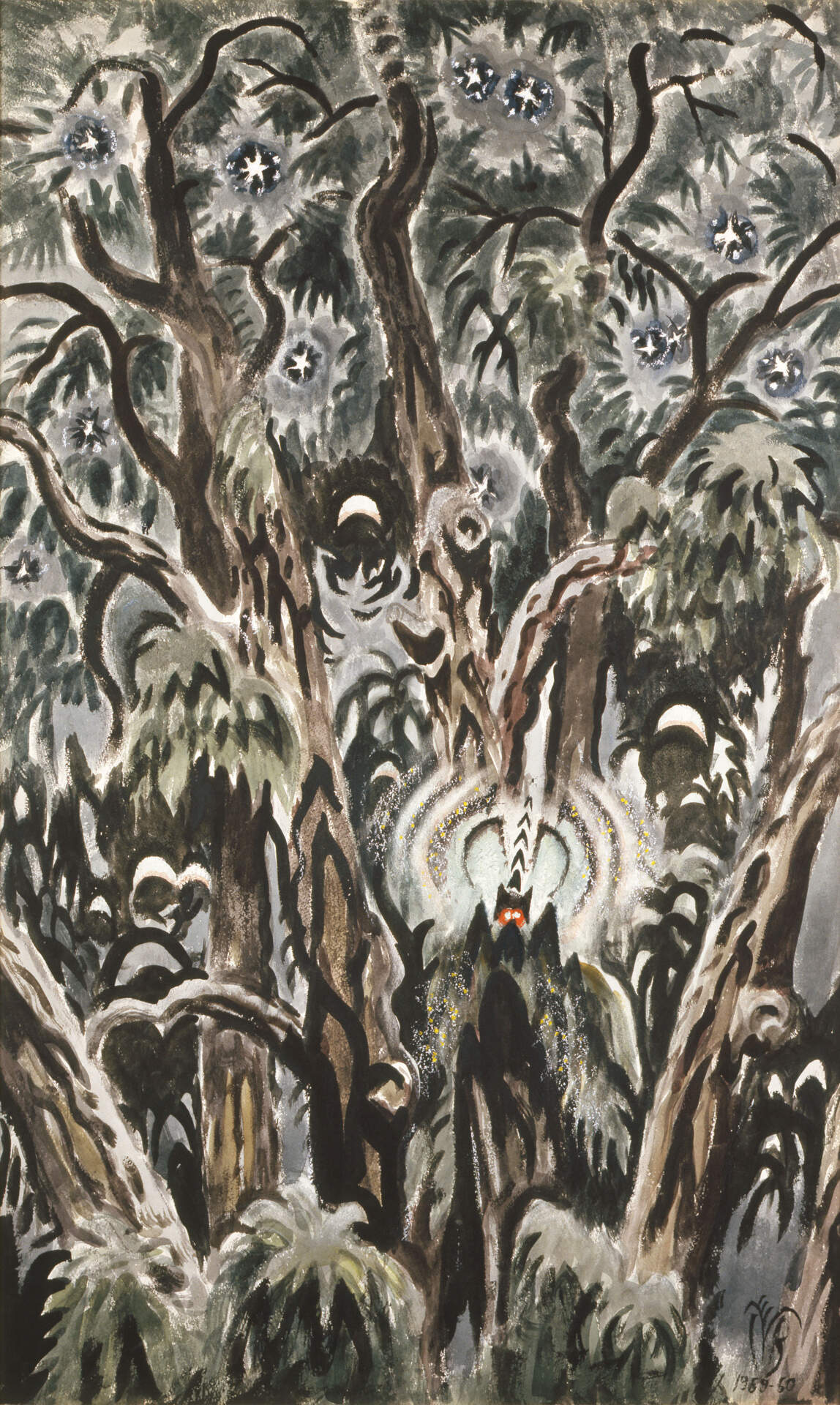Charles E. Burchfield (1893-1967)Song of the Tree Cricket
1959-60
Watercolor, gouache, white chalk and black charcoal on wove paper
44 x 27 inches (frame 58 ¾ x 41 5/8 x 2 5/8 inches)
Burchfield Penney Art Center, Purchase and gift made possible by John Sacret Young, 2003
In August 1959 Burchfield went to his backyard “to listen to the tree-cricket chorus. The skies had cleared off, and stars were very brilliant—Jupiter, first seen behind the ash tree so brilliant I thought it was the ‘new’ crescent moon. Under the willow-tree looking upward through its night-obscured branches, which seemed to extend up to infinity—stars sparkling through the leaves.” The artist often converted the sounds of nature and music into visual patterns or “audio-cryptograms” as a form of synesthesia. —Nancy Weekly
In 2006, John Sacret Young wrote to Nancy Weekly about this painting that he ultimately purchased for us as we shared ownership: "I knew when I saw it that it was unique among the works of CEB that I had seen, but it doesn't jump off the wall at you. Rather, when lit—it walks you into its mystery and unique perspective and unique maze of vines and stars and wonder and dreams—and of course 'song' but with a degree of delicate intricacy (the interlacing of the branches) and a small fundamental ferocity (that tree cricket) that I think sort of has no bottom."
On October 4, 1957 the Soviet Union launched the first man-made satellite into outer space. The event caught the attention of everyone, not least the United States government. An article in the New York Times from October 13 of that year referred to the satellite as “the first man-made moon.” Burchfield was certainly not immune to the excitement. In August of 1959 he spent time painting a willow tree with stars and planets studded beyond its limbs. While listening to the insects in the summer air, he described his feelings about space:
Then out to backyard to listen to the tree-cricket chorus. The skies had cleared off, and stars were very brilliant—Jupiter, first seen behind the ash tree so brilliant I thought it was the “new” crescent moon…Under the willow-tree looking upward through its night-obscured branches, which seemed to extend up to infinity—stars sparkling through the leaves. A wonderful sensation, —and at last I suddenly realized I was completely free of the disturbing obsession of outer space that started in my mind when Sputnik I was put into orbit. I feel that I could sense more of Infinity and God through looking up into this night-willow, than if I sailed to Jupiter and beyond in a space-ship.
Song of the Tree Cricket (1959-60) features a remarkably unusual perspective, reminiscent of a fireworks show, made of arching, star-shaped branches, leaves and brilliant explosions of starlight. Although it is not clear which specific stars Burchfield included in this work, two of them might be the planets Jupiter and Saturn, which could have been visible in the south-southwestern sky as he made his observations. Three days later, Burchfield wrote:
P.M. –Painted the willow tree at night, showing stars sparkling thru openings on the upper foliage, and using eerie tree-cricket motifs in the lower part. At the end I felt chagrined that I had failed to give the sense of looking up thru the tree to the sky, but Bertha agreeing with that, said it was beautiful anyway, whether it achieved that one aim or not. Later I came to see that too.
- From the exhibition Charles E. Burchfield: Oh My Heavens
